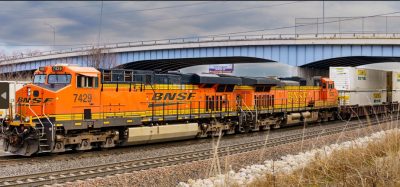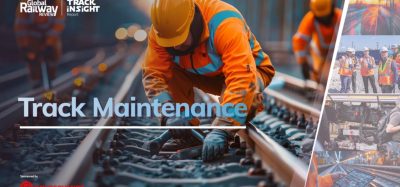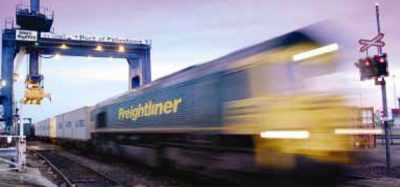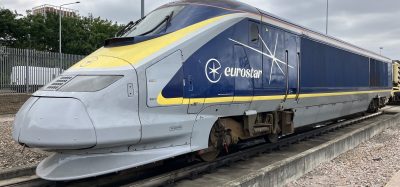Branching out to stay competitive
Posted: 26 November 2007 | | No comments yet
In 1999, Freightliner Group identified a significant opportunity for the company to enter the bulk freight market, and established Freightliner Heavy Haul Ltd (FHH). In an interview for the Global Railway Review, Tim Shakerley explains how starting from scratch, the company has quickly grown in the bulk rail business, branching out into numerous sectors of the industry, including aggregates, cement, petroleum, waste and infrastructure services.
In 1999, Freightliner Group identified a significant opportunity for the company to enter the bulk freight market, and established Freightliner Heavy Haul Ltd (FHH). In an interview for the Global Railway Review, Tim Shakerley explains how starting from scratch, the company has quickly grown in the bulk rail business, branching out into numerous sectors of the industry, including aggregates, cement, petroleum, waste and infrastructure services.
In 1999, Freightliner Group identified a significant opportunity for the company to enter the bulk freight market, and established Freightliner Heavy Haul Ltd (FHH). In an interview for the Global Railway Review, Tim Shakerley explains how starting from scratch, the company has quickly grown in the bulk rail business, branching out into numerous sectors of the industry, including aggregates, cement, petroleum, waste and infrastructure services.
Coal was one of the earliest sectors which FHH entered and today it is by some margin the largest sector in the business. The coal business continues to grow year on year and currently represents approximately 50% of FHH’s turnover. Last year, coal haulage capacity increased by 22% and will increase again by another 18% this autumn, with the arrival of another 110 new coal hopper wagons.
In response to the UK’s growing coal freight market and the customer appetite for competition between rail operators, FHH has significantly expanded over the last six years. This is due to contract renewals with increased volumes for existing customers, as well as new customers attracted to FHH by its reputation for high quality of service. FHH continues to develop and expand through investing in new equipment and technology, as well as staff and training.
“An integrated approach allows the customer unrivalled reliability, as well as flexibility, for the planning and execution of the large and complex movements that characterise the coal market,” explains Tim Shakerley.
Major developments this year have seen a contract win with E.ON UK, in which FHH has recently begun operating coal trains from Hatfield Colliery near Doncaster. The mine has recently reopened and resumed mining and on 24 July, the first train carried coal to Ratcliffe-on-Soar power station. This represented the start of the first rail haulage contract between FHH and E.ON UK and is part of a new long-term deal to move significant volumes of coal to Ratcliffe and Ironbridge power stations.
“These are exciting times for FHH”, says Mr. Shakerley. “This new deal, along with our other recent contract renewals, is due to our proven record of service performance and our ability to give bespoke solutions to our customers through commitment and flexibility. Our continual investment, such as our recent orders for additional class 66 locomotives and wagons, demonstrates a massive and continuing investment into the haulage of coal for the electricity supply industry in the UK.”
FHH continues to invest to support their contract renewals, and they have ordered a further 110 HXA coal hoppers currently being delivered. This will take FHH’s fleet of coal wagons to over 650 hoppers, including over 200 HXA wagons. The drive for efficiencies to deliver reliable and competitive services for customers, plus the need to use rail paths on the UK’s rail network more effectively, has lead to a need to increase the volume of coal hauled by each train. Since FHH’s inception, the introduction of the HHA wagon, followed by its successor the HXA, has significantly increased payload per train when compared to the ex-British Rail 30 tonne hopper wagon. Both FHH wagons have track-friendly bogies, minimising the wear and tear on the track, reducing the time and money having to be spent on track maintenance and repairs. However, the HXA (introduced in 2007), has again moved on the development of coal wagons, optimising performance. It is almost three feet shorter than the HHA but can still carry the same volume, achieved by increasing the slope angles within the wagon. Slope angles are critical, dependent on the product flow of the commodity that the wagon is designed to carry. If the slope is wrong then the product will stick, requiring there to be a compromise between capacity per length of wagon and angle, bearing in mind the volume of product the wagon is designed to carry – which with the HXA’s is 79 tonnes of coal. The flow of product in the wagon is also assisted by the partitions in the middle, aiding with the discharge of product, without which the product would stick in the centre portions. With the introduction of the HXA, Freightliner took the opportunity to make minor modifications to optimise performance. There have been no problems with the HHA, but in typical Freightliner fashion there is a continual drive for improvements and evolution. Modifications on the HXA have included more robust door gear where additional cylinders have been added to operate each door to improve reliability and therefore getting more utilisation out of the new wagons.
“The HXA’s are an evolution of the engineering used in the development of the HHA, wherever possible optimising performance”, says Mr. Shakerley.
Investment continues within the Group, with a further order of low emission class 66’s recently announced and rolling stock needs continually assessed. In 2005, this investment in engineering stretched to the establishment of a new subsidiary, Freightliner Maintenance Ltd (FML), which took over the assets and staff of LNWR’s former Leeds Midland Road depot, together with field engineering support in Scotland and the South East. FML operates as a separate entity dedicated to the repair and maintenance of traction and rolling stock.
“FML is driving value into the business step change in improvements in reliability and availability at an affordable price,” says Mr. Shakerley. “Mixing sound supplier knowledge with in house capability allows Freightliner the best of both worlds.”
Initially, the Midland Road depot was just used for scheduled maintenance and repairs of the FHH fleet of locomotives, but has now taken over the maintenance of the fleet of HHA and HXA coal wagons. In addition to this, FML have also taken over the maintenance of 322 PCA Lafarge Cement wagons. In a landmark deal this year, FHH’s relationship between FHH and LCUK (Lafarge Cement) was further strengthened by a ‘sale and leaseback’ of LCUK’s fleet of 322 cement tank wagons to FHH. While LCUK are able to concentrate on their core business, FHH take responsibility to deliver a complete rail freight package, with FML taking over the control repair and maintenance from depots at Hope and Dunbar and field support engineers across the country.
Mr. Shakerley continues: “This is a vote of confidence that we are doing the right thing; allowing our customer to concentrate on manufacturing cement, while we can use our rail engineering expertise to take over the management and safety assurance of their fleet of wagons.”
The success Freightliner has experienced in the UK since privatisation has led them to transfer their expertise outside the UK. As the UK coal market is becoming increasingly dependent on exports, Freightliner Group Ltd recently entered the European market, establishing a Polish subsidiary, Freightliner Poland (FPL). Poland is one of the world’s largest producer and exporter of coal; its share of European production is 25%. FPL is prepared and their entry into the Polish market is supported by brand new rolling stock. Last year, Freightliner Group invested £30 million in new rolling stock, including seven class 66 locomotives and 432 wagons for FPL. Investing in new locomotives is a milestone for the rail freight industry in Poland and FPL is breaking the investment deadlock of the past two decades. In addition, they are one of the first private freight companies in Poland to use class 66 locos, which are Europe’s most reliable and efficient diesel engines and geared for cross border operations into Germany. These brand new low emission locos have been certified under the interoperability directives through the Polish UTK notified body. Although 66’s have run in Poland, this is the first low emission loco to be certified for use on the continent. All the usual modifications for fitting the European signaling system and European cap were completed in Tilburg before delivery to service.
The state-of-the-art wagons have brought innovation and economies of scale to the Polish rail freight market. They are specifically designed to carry coal or aggregates, and have a carrying capacity of almost 70 tonnes despite a shorter length than traditional wagons. On some routes, FPL can therefore carry some 17% more payload than a standard wagon. FPL has provided the largest single investment into Poland by a private operator. The investment in new locomotives and wagons also represents the first investment in brand new operating equipment in Poland for over 15 years. FPL commenced its first commercial contract on 1 September 2007 operating services to Kozeince Power Station.
Mr. Shakerley concluded: “Investing in new rolling stock is parallel to what Freightliner has done in the UK; making investments which enable us to optimise the amount of payload that a train can carry within the permissible train length. Although the train lengths in Poland are much longer than the UK – up to 40 wagons long and carrying up to 4000t of coal – we are still constricted by the signal spacing and compared to the conventional type of wagon our investment enables us to operate more wagons per train and locomotive.”
Freightliner’s engineering team will continue to strike their tried and tested blend of innovation and optimisation to aim for further breakthroughs in technology, capacity and efficiency. A problem faced with investment, particularly on rail, is it usually takes at least a decade to see results that impact the bottom line. Because new rolling stock generally comes with a design life of 25-30 years, technology decisions have to be lived with for decades to come. You have got to tread a fine line between innovation – high risk, high expense – against recognising that you have to move the rail freight business forward; that is, looking at ways to make it more economic in order to stay competitive.
Issue
Related topics
Cargo, Freight & Heavy-Haul, Rolling Stock Orders/Developments







